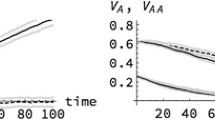Summary
Selection experiments can provide information on genetic parameters such as realized heritability and response to selection. Often, due to lack of adequate replication, empirical sampling variances of estimated response cannot be computed and therefore use must be made of theoretical formulae. Most of the variance between a conceptually large number of selected lines drawn from the same base population is contributed by genetic drift, which depends on the population structure and can therefore be predicted before the experiment is carried out. The theory of variation of response to selection has been developed mainly by Hill, who produced formulae to adjust the variance of estimators to take account of genetic drift. In this paper, we draw attention to properties of the additive genetic relationship matrix that lead to well established results in population genetics theory. We show how inclusion of the additive genetic relationship matrix among the observations leads to sampling variances of estimators of genetic means that account for the variance due to genetic drift.
Similar content being viewed by others
References
Avery PJ, Hill WG (1977) Variability in genetic parameters among small populations.Genet Res 29:198–213
Bulmer MG (1971) The effect of selection on genetic variability.Am Nat 105:201–211
Falconer DS (1981) Introduction to quantitative genetics. Longmans, New York
Hill WG (1971) Design and efficiency of selection experiments for estimating genetic parameters.Biometrics 27:298–311
Hill WG (1972) Effective size of populations with overlapping generations.Theor Popul Biol 3:278–289
Hill WG (1974) Prediction and evaluation of response to selection with overlapping generations.Anim Prod 18:117–139
Hill WG (1977) Variation in response to selection. In:Int Conf Quant Gen.Iowa State University Press, Ames, pp21–30
Robertson A (1961) Inbreeding in artificial selection programmes.Genet Res 2:189–194
Robertson A (1977) Artificial selection with a large number of linked loci. In: Int Conf Quant Gen.Iowa State University Press,Ames, pp02–105
Thompson R (1977) The estimation of heritability with unbalanced data. 2. Data available on more than two generations.Biometrics 33:497–504
Wright S (1922) Coefficients of inbreeding and relationship. Am Nat 56:330–338
Author information
Authors and Affiliations
Additional information
Communicated by D. Van Vleck and A. Robertson
Rights and permissions
About this article
Cite this article
Sorensen, D.A., Kennedy, B.W. The use of the relationship matrix to account for genetic drift variance in the analysis of genetic experiments. Theoret. Appl. Genetics 66, 217–220 (1983). https://doi.org/10.1007/BF00251147
Received:
Accepted:
Issue Date:
DOI: https://doi.org/10.1007/BF00251147




